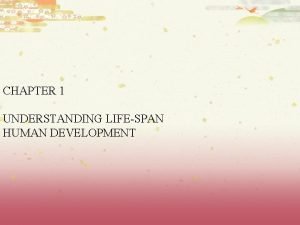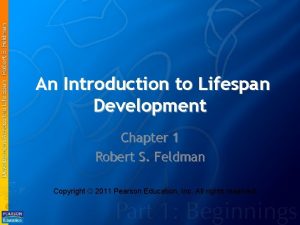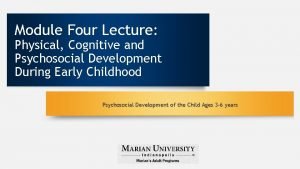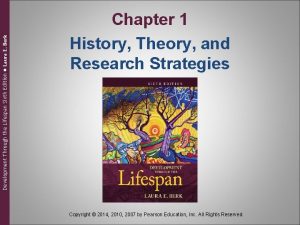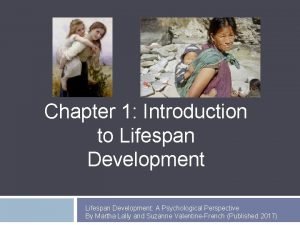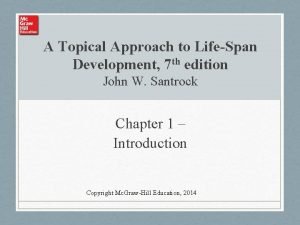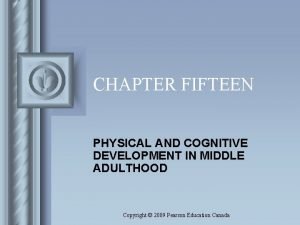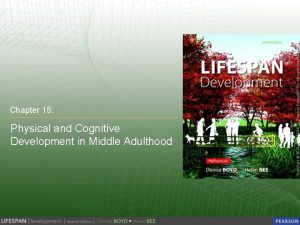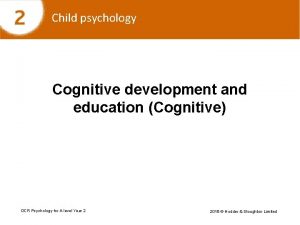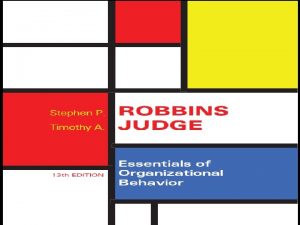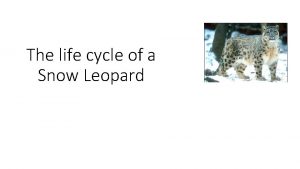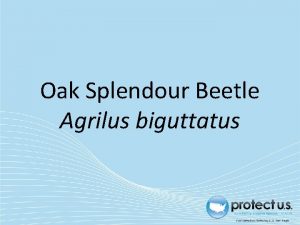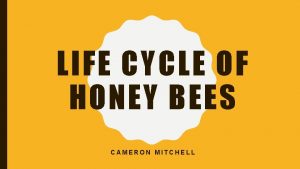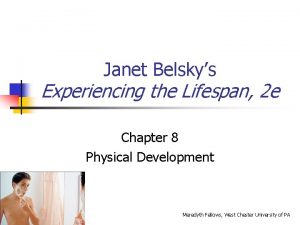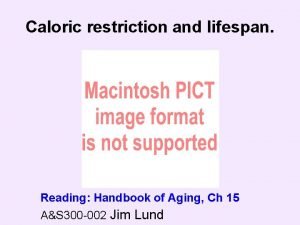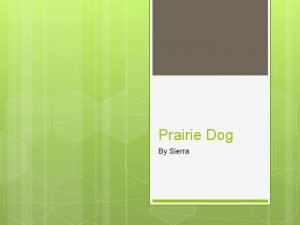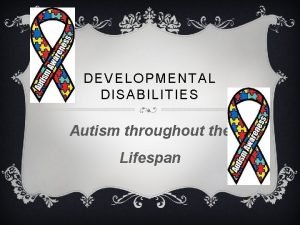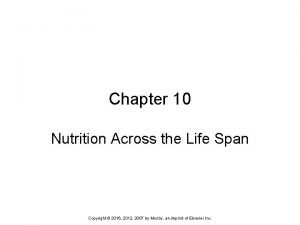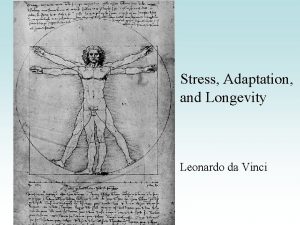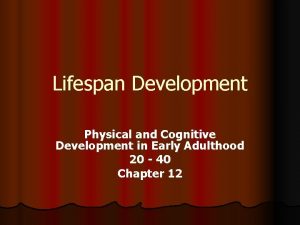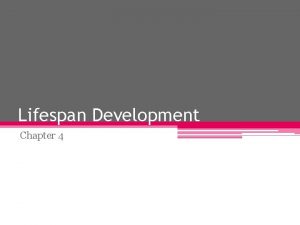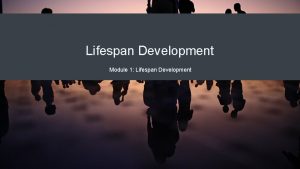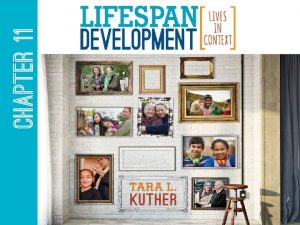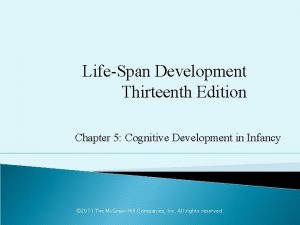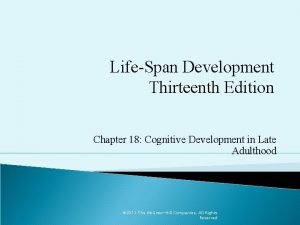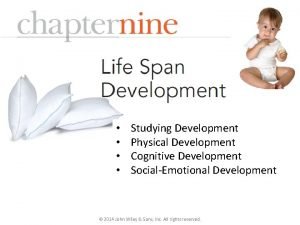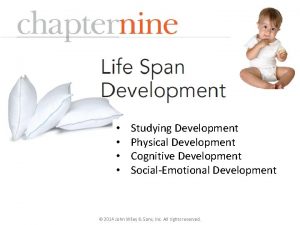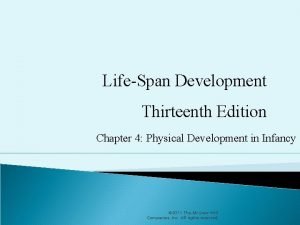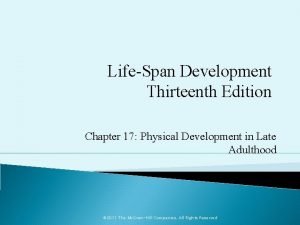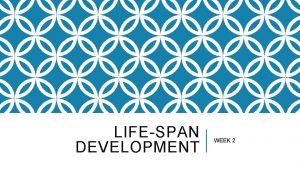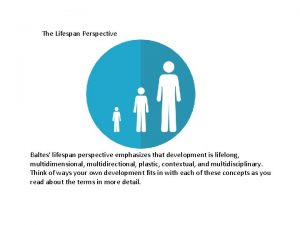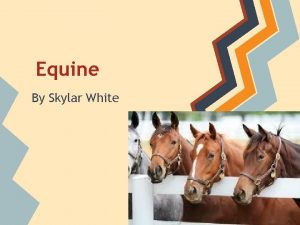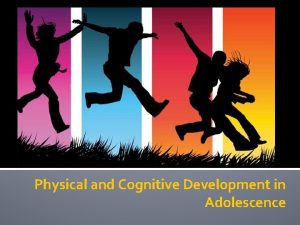Chapter 9 Lifespan Development I Physical and Cognitive





































- Slides: 37

Chapter 9 Lifespan Development I: Physical and Cognitive Development

Physical and Cognitive Development Timeline Take a piece of 11 x 15” paper each. In the middle of the paper draw a horizontal line On the top of the paper, write physical development in small letters On the bottom of the paper, write cognitive development in small letters Draw short vertical marks on the centre line to indicate what you decide are significant years. Mark what you think were physical and cognitive milestones through your experience of developing and growing up. You may also use Google or use what you know having watched children in your life develop as well.

Continuous Development vs. Stages The idea behind stages of development comes from the nature side of the nature vs. nurture debate. There are critical periods of time in which we are extra sensitive to specific experiences that help us develop to our optimal capacity. If a certain skill is not learned during the critical period, it will hamper our ability to develop properly in the future and progress optimally in other stages. For example, the idea is that we first learn to crawl at a certain age and when we have hit that milestone in the appropriate time frame, we move on to the stage of walking.

Continuous Development vs. Stages The idea behind continuous development is largely based on the nurture side of the nature vs. nurture debate. The idea is that we develop as a result of role models and input from our environment in a continuous manner. For example, the idea is that we learn to crawl because we observe people in our environment modeling the movement for us.

Personality Test Use your phone or device to do the following personality test: http: //www. personalitytest. net/ipip/index. html Use the short version

Personality and Intelligence Discuss with a partner – How would you define personality? Intelligence? On your timeline, add information about what you know of your personality and intelligence over time. Think back to old report cards and stories your parents may have told you when you were young. Has your personality and intelligence changed or have they stayed the same over time?

Intersectionist Perspective Very similar to the biopsychosocial model, which evolved out of the intersectionist perspective. It is the idea that there is no one way that humans develop: Some developments might have critical periods and occur in stages Others might occur continuously Some traits might be inborn and therefore stable Others might be changing All of the above might varying depending on the environment, genes, and how both interact

Studying Human Development There are two different types of studies that researchers can use to study human development over time. 1. Cross-sectional research: - the research is all done at the same time - researchers look at multiple different groups of people at different ages. (e. g. 1 group at age 20, 1 group at age 40, 1 group at age 60) - results are immediate, quick, and allow for a large sample size

Studying Human Development There are two different types of studies that researchers can use to study human development over time. 2. Longitudinal Research: - research is completed at different time increments (e. g. 2016, 2036, 2056) - the same group of participants is studied at different ages - individual differences don't impact the research, because it is the same participants each time - can get more in-depth information per participant

Developmental Psychology Applied Child Psychologists: Work with children who appear to be developing differently than the average child – they help identify what is going on, why, and how we can best help each child Work with children with developmental disabilities to help them, their teachers, their workers, and their families May be able to identify abuse and neglect based on how a child is developing differently than they should Help teachers understand how children at different ages learn best and what they are capable of learning

Physical Development: Germinal Period: First two weeks of life Starts with ovulation and ends with implantation The fertilized ovum is called a zygote at this stage and travels into the uterus for implantation.

Physical Development: Embryonic Period: Zygote becomes an embryo From implantation to the 8 week mark (6 weeks in length) The head is growing faster than the body The major organ systems differentiate from each other The most critical period in development as this is when the embryo is most susceptible to devastating damage as a result of drugs, radiation, disease, etc. Placenta

Physical Development: Fetal Period: 2 months to birth (lasting 7 months) Embryo is now called a fetus By 4 months all of the body parts and organs have been established Largely growing and “fine detailing”

Environmental Impacts on an embryo/fetus Maternal Factors: Paternal Factors: - Stress - - Malnutrition Consumption of drugs or alcohol - Exposure to chemicals • Paternal factors largely affect the development of the sperm (with the exception of smoking around the mother or abuse of the mother) - Disease - Exposure to chemicals • Maternal factors can effect both the development of the egg and the embryo/fetus in utero as it develops

The impact of smoking while pregnant Children whose mother smoked during pregnancy or whose mother was regularly exposed to second-hand smoke: - Have lower birth weights - Are more likely to be premature - Have higher rates of fetal deaths - Are at higher risk of sudden infant death syndrome (SIDS) - Are more likely to have behavioural and cognitive problems

The impact of drinking while pregnant: Features of fetal alcohol spectrum disorder and fetal alcohol syndrome: - Low birth weight and small head circumference - Failure to thrive - Developmental delay - Organ dysfunction - Epilepsy - Poor coordination/fine motor skills - Poor social skills - Lack of imagination or curiousity - Learning difficulties - Behavioural problems - Facial abnormalities

Debate Topic: Should there be a penalty for parents who smoke and/or drink during pregnancy/around a pregnant mother? If so, what should it be? What are the pros and cons to implementing such a penalty?

Child Development: Motor Development Look at the visual depicting motor development on page 250. Do you think this demonstrates development in stages or continuous development? Psychology Applied: The Physical Education curriculum is based on what we know about motor development. Students are taught to throw a ball, when developmental psychology says they should be capable of that level of hand-eye-coordination. For that reason, in younger grades, they may start by just rolling a ball and move up to throwing and catching in higher grades.

Child Development: Sensory and Perceptual Development At birth, babies can smell most odours and distinguish between salty, sweet, sour, and bitter tastes. Touch and pain senses are highly developed Hearing is highly developed with the fetus reacting to sounds as early as 25 weeks Vision is poorly developed when babies are born. See the visual on page 251 under figure 9. 11

To what extent is adolescence a product of culture? In North America, individuals are not expected to assume much responsibility until they are graduated high school – usually around 17 or 18. Even then, some are not expected to assume much more responsibility until after college. In many other places in the world, children are put straight to work from a young age. To what extent do you think adolescence and the attitude that comes with it is a product of culture versus something biological? (nature vs. nurture) Provide evidence for your argument. Completely a product of culture 50 -50 split Completely a product of our biology

Adolescent Development See Figure 9. 13 on page 252 to see how adolescence differs in females and males chronologically speaking. Females: menarche (menstruation) caused by maturation and hormone secretion; development of ovaries, vagina, pubic hair and breasts Males: spermarche (first ejaculation); development of testes, scrotum, penis, pubic hair, deepening of the voice, and growth of facial hair

Adult Development Slow after adolescence until middle age Menopause – the cessation of the menstrual cycle between the ages of 45 and 55 Women also face the social devaluation of aging women and pressures to maintain youthful beauty, which can result in depression and anxiety http: //www. theguardian. com/film/2015/may/21/maggiegyllenhaal-too-old-hollywood Male Climacteric - Men have a gradual decline in sperm production and testosterone, weight gain, decline in sexual responsiveness, loss of muscle strength, and greying or loss of hair. Although men don’t face the same societal pressures, they are faced with their mortality, which can cause depression in men and women.

Aging Primary Aging is the inevitable and gradual age related changes to physical and mental processes Secondary Aging changes from the results of disease, disuse, or neglect Make a list of changes that you’ve observed in older adults that would be categorized as primary aging Make a list of factors that contribute to secondary aging and examples. Ageism is prejudice or discrimination based on physical age and is also a common problem faced by those who are older adults.

Theories of Aging Programmed theory – aging is genetically controlled and happens at a biologically predetermined times in your life Damage theory – an accumulation of damage to cells and organs over the years ultimately causes aging and death

Psychology Applied: Working with different age groups Psychologists/counsellors often specialize (as with other professions) in working with different age groups because the needs between age groups vary so greatly. In groups of 3 – 4 make a list to share with the class of age-related common problems that someone in each age group might seek counselling for: Child (e. g 7) Teen/Adolescent (e. g. 15) Young Adult (e. g. 21) Adult (e. g. 35) Middle-age (e. g. 50) Older Adult (e. g. 75)

Existentialism and Aging A common bother for many people that is related to aging, but can come up in our lives at any time (whether it be triggered by watching others age or ourselves), is “What is the meaning of life? ” “Why are we here? ” and “What is my purpose? ” Existentialism is a psychological theory that focuses on the importance of these questions in our lives. Reflect on them yourself. What do you think the answers are?

Cognitive Development - Piaget Jean Piaget was one of the first cognitive psychologists to focus on childhood development. Definitions to understand: - Schema – basic patterns in our thinking and beliefs that help us organize ideas and interpret the world; grow and change over time - E. g. a child develops a schema for animals, starting with the first one they are familiar with

Cognitive Development - Piaget Jean Piaget was one of the first cognitive psychologists to focus on childhood development. Definitions to understand: - Assimilation – when new information is absorbed into existing schemas without changing them - Accommodation – when a schema is changed or adjusted as a result of new information being presented and integrated in

Piaget’s Stages of Cognitive Development See Study Organizer 9. 1 on page 256 Sensorimotor Stage Age Key Concepts Abilities Birth – 2 yrs In this stage, children acquire object permanence – they realize that things that can’t be seen, touched , or heard still exist (e. g. why hide and seek is so funny!) Uses sense (especially the mouth!) and motor skills to explore their world and learn.

Piaget’s Stages of Cognitive Development See Study Organizer 9. 1 on page 256 Preoperational Stage Age Key Concepts Abilities 2– 7 yrs In this stage, children do not have operations, which are reversible mental processes. (e. g. understanding that if they have a brother they are also a brother themselves) Children are egocentric, which means that they think that others think, feel, see, and hear exactly like they do. (e. g. nodding their head in a phone conversation because they assume their caller will know) Children have an animistic perspective in which they think inanimate things have motives, feelings, and intentions. (e. g. their teddy bear is sad and hurt, because its stuffing is coming out) Language progresses quickly and can think symbolically (e. g. make believe)

Piaget’s Stages of Cognitive Development See Study Organizer 9. 1 on page 256 Concrete Operational Age Key Concepts Abilities 7 – 11 yrs Children learn conservation – certain physical attributes (such as volume of water) stays the same even when the outward appearance changes (because they understand operations and reversibility now) Lack hypothetical and abstract thinking. Less egocentric Can think logically about concrete objects and events

Piaget’s Stages of Cognitive Development See Study Organizer 9. 1 on page 256 https: //www. youtube. com/watch? v=Jk 2 n. LNfz. Vr. Y https: //www. youtube. com/watch? v=Pzy. XGUCngo. U Formal Operational Age Key Concepts Abilities 11 + yrs Adolescent Egocentrism characterized by: The personal fable – intense investment in his or her own thoughts and feelings = his or her thoughts and feelings are unique (e. g. no one knows or understands what I’m going through!!) Imaginary Audience – the belief that they are at the centre of everyone’s thoughts and feelings (I have a zit and can’t go to school because everyone will notice and talk about me) Can think abstractly and hypothetically and as a result, test out hypothetical futures and make a plan based on the ones with the best outcome

Piaget – Criticisms and Contributions Underestimated abilities – many critique Piaget for underestimating the abilities of children - E. g. young babies cry when other babies do possibly showing empathy and certainly not egocentrism and a preschooler will adapt his or her speech to short sentences to talk to a 2 -year old Ø Underestimating genetic and cultural influences – Piaget’s theory doesn’t take into account how a child might develop from a private school elite education versus a school in a refugee camp for example. It also doesn’t take in account how people may answer questions differently based on their culture, not their reasoning (e. g. the importance of community vs. the individual)

The surprisingly logical mind of babies https: //www. ted. com/talks/laura_schulz_the_surprisingly_logical_minds_of_ babies/citations

When does learning begin? https: //www. ted. com/talks/annie_murphy_paul_what_we_learn_before_we_ re_born/transcript? language=en

What do babies think? https: //www. ted. com/talks/alison_gopnik_what_do_babies_think? language=e n

Discussion Questions In groups of 2 – 3 answer one of the following discussion questions: Discuss some of the physical issues that are confronted during middle age and later adulthood. What are the implications of these for psychological well-being? Identify each of Piaget's four stages of cognitive development. Discuss the child's abilities and limitations at each stage. Describe the characteristics of menopause and male climacteric, including their physical and psychological effects.
 Openstax
Openstax Physical development
Physical development Exploring lifespan development chapter 1
Exploring lifespan development chapter 1 Exploring lifespan development chapter 1
Exploring lifespan development chapter 1 Early adulthood cognitive development
Early adulthood cognitive development Physical development during early adulthood
Physical development during early adulthood Define physical cognitive and psychosocial development
Define physical cognitive and psychosocial development Guidance counselling and lifespan development
Guidance counselling and lifespan development Cognitive and non cognitive religious language
Cognitive and non cognitive religious language Development through the lifespan 6th edition
Development through the lifespan 6th edition Discontinuous development psychology
Discontinuous development psychology A topical approach to lifespan development
A topical approach to lifespan development Lifespan development third edition
Lifespan development third edition Lifespan development third edition
Lifespan development third edition Chapter 5 cognitive development in infancy and toddlerhood
Chapter 5 cognitive development in infancy and toddlerhood Early childhood is ____ for language learning
Early childhood is ____ for language learning Denny's model of physical and cognitive ageing
Denny's model of physical and cognitive ageing Denny's model of physical and cognitive ageing
Denny's model of physical and cognitive ageing Late childhood
Late childhood Module 47 infancy and childhood cognitive development
Module 47 infancy and childhood cognitive development Cognitive development and education
Cognitive development and education Module 47 infancy and childhood cognitive development
Module 47 infancy and childhood cognitive development The investment of an employee's physical cognitive
The investment of an employee's physical cognitive Snow leopard lifecycle
Snow leopard lifecycle Gulper eel habitat
Gulper eel habitat Petit four base
Petit four base Splendour beetle
Splendour beetle Life span of honey bee
Life span of honey bee Ponce de leon nationality
Ponce de leon nationality Janet belsky
Janet belsky Henry hudson
Henry hudson Lifespan of every animal
Lifespan of every animal The developing person through the lifespan
The developing person through the lifespan Prairie dogs fun facts
Prairie dogs fun facts Autism lifespan
Autism lifespan Nutrition across life stages
Nutrition across life stages Eagle lifespan
Eagle lifespan Da vinci lifespan
Da vinci lifespan


